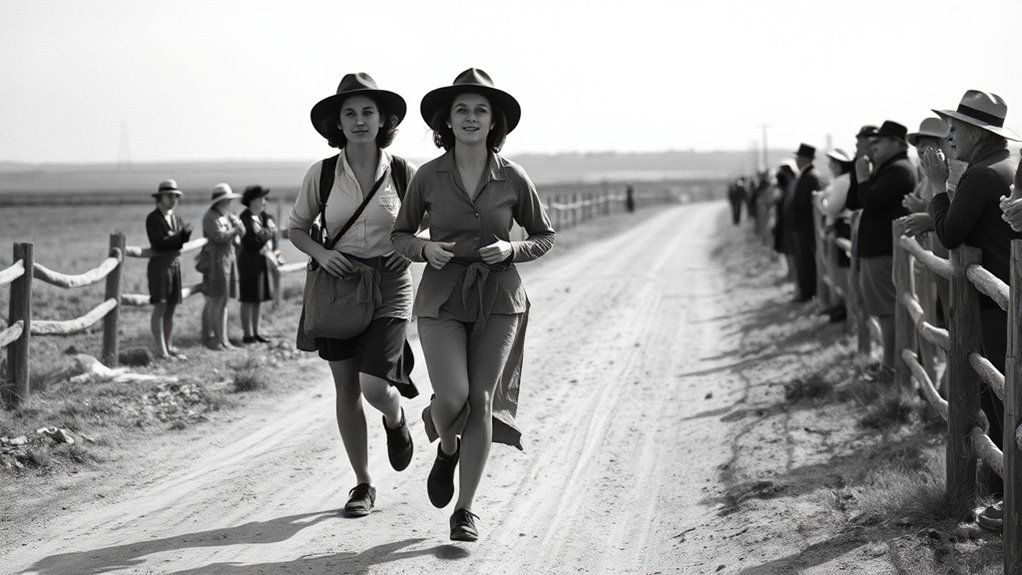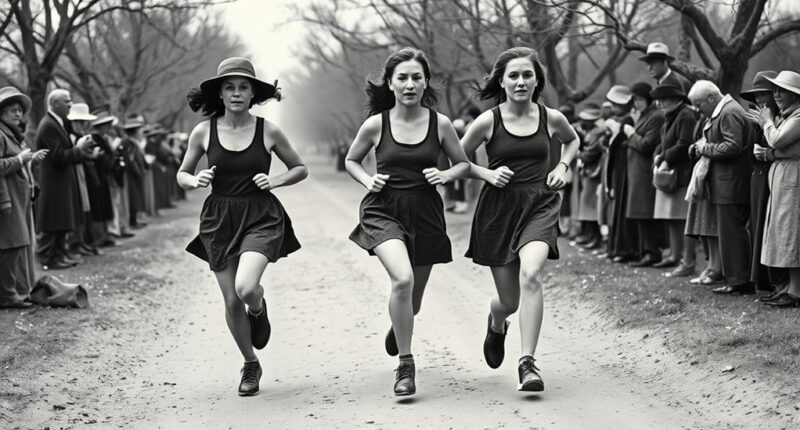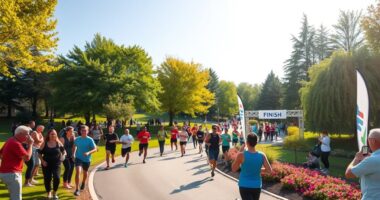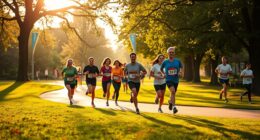The first women to run marathons faced significant societal barriers and skepticism. Kathrine Switzer made history in 1967 as the first registered female participant in the Boston Marathon, despite officials trying to remove her. Roberta Gibb also ran unofficially a year earlier, proving women could endure long-distance races. Their courage challenged stereotypes and pushed for gender equality in sports. Keep exploring to discover how their pioneering efforts continue to inspire athletes today.
Key Takeaways
- Kathrine Switzer was the first registered woman to run the Boston Marathon in 1967, challenging gender norms.
- Roberta Gibb ran the Boston Marathon unofficially in 1966, paving the way for women’s participation.
- Both women faced institutional resistance but demonstrated women’s endurance in marathon distances.
- Their efforts inspired societal and sports policy changes toward gender equality in athletics.
- Their pioneering actions are celebrated as key milestones in women’s marathon history.

Running a marathon was once considered an achievement reserved for men, but a few brave women challenged that notion early on. These women broke barriers and redefined what was possible, inspiring generations to come. Their efforts weren’t just about personal achievement; they played an essential role in advancing gender equality, showing the world that women could compete at the highest levels of athletic performance. In the early days, societal norms and institutional barriers made it difficult for women to participate in such demanding events, yet these pioneers pushed through those limitations, setting important athletic milestones along the way.
Women pioneers in marathon running challenged norms, broke barriers, and advanced gender equality through perseverance and athletic milestones.
One of the earliest known women to challenge the status quo was Kathrine Switzer. In 1967, she entered the Boston Marathon as the first registered female participant, despite efforts by race officials to physically remove her from the course. Her determination made headlines and forced officials to reconsider policies on women’s participation in long-distance running. Switzer’s breakthrough was more than just a personal achievement; it was a statement for gender equality in sports. Her actions demonstrated that women belonged in marathons and other endurance events, challenging stereotypes that questioned women’s physical capabilities and endurance.
Another trailblazer was Roberta Gibb, who ran the Boston Marathon unofficially in 1966, months before Switzer’s more well-known run. Gibb faced skepticism and criticism, but her perseverance proved that women could endure the same grueling distances as men. Her pioneering spirit set a precedent, inspiring other women to take part in marathons and pushing the boundaries of what society believed women could accomplish. These early efforts helped shift public perception, gradually transforming marathon running into an inclusive sport where women’s participation became normalized. Additionally, the development of electric bikes and their increasing popularity have made training and participating in long-distance events more accessible for women and all athletes, fostering greater inclusivity and endurance.
Over time, these athletic milestones contributed to broader societal change. Women’s marathon records continued to fall, and more women began competing at elite levels. The inclusion of women in official marathon events, such as the Boston Marathon’s recognition of female runners, marked a significant step forward in gender equality within athletics. Today, female marathoners are celebrated for their strength, endurance, and resilience, but it’s important to remember the pioneers who paved the way. Their courage and determination challenged gender stereotypes and helped forge a more equitable sporting landscape, proving that persistence and passion can shatter barriers and inspire progress.
Frequently Asked Questions
What Inspired These Women to Start Running Marathons?
You’re inspired to run marathons because these women broke gender barriers and challenged societal expectations. As athletic pioneers, they aimed to prove that women could endure and excel in demanding sports. Their determination and courage motivate you to push past limits, embrace your strength, and pursue your passion for running. Their legacy encourages you to defy stereotypes and stand as a proof of perseverance and empowerment in athletics.
How Did Societal Attitudes Affect Their Participation?
Societal attitudes, shaped by gender stereotypes and societal barriers, often hindered your participation in marathons. People doubted women’s endurance and questioned if running was appropriate for your gender. These societal pressures created obstacles, but your determination challenged those stereotypes. You pushed through the barriers, proving that women could compete in marathon running and inspiring future generations to break free from limiting expectations.
Were There Any Specific Training Methods They Used?
You’ll be surprised to learn that these women used innovative training routines, often running daily to build stamina, despite societal doubts. They also experimented with footwear innovations, like lightweight shoes, to improve performance. For example, some trained in homemade or men’s shoes, adapting their gear to suit their needs. Their dedication and clever use of new techniques helped break barriers, proving that perseverance and smart training can defy societal expectations.
What Challenges Did They Face During Their First Marathons?
During your first marathons, you face gender barriers that questioned your abilities and societal expectations. Media coverage often sensationalized or criticized your participation, making it harder to focus. You might struggle with self-doubt fueled by stereotypes, but pushing through these challenges proves your strength. Overcoming gender barriers and steering through media scrutiny shows your resilience, inspiring future women runners and changing perceptions about women’s athletic capabilities.
How Did Their Achievements Influence Future Female Runners?
Their achievements shattered gender barriers like a lightning bolt, inspiring you to believe in limitless possibilities. By breaking societal norms, they paved the way for future female runners, fueling sports advocacy and pushing for equal opportunities. Their courage showed you that perseverance can overcome obstacles, encouraging more women to lace up and chase their dreams, transforming running into a symbol of empowerment and change for generations to come.
Conclusion
Remember, history favors the bold. As you’ve seen, these women broke barriers and proved that determination knows no gender. Their courage paved the way for countless others to chase their marathon dreams. Don’t let doubts hold you back—just lace up, step forward, and run your own race. Every champion starts as a challenger, so keep pushing boundaries and inspiring change. Your journey begins today—go ahead and make your mark.









